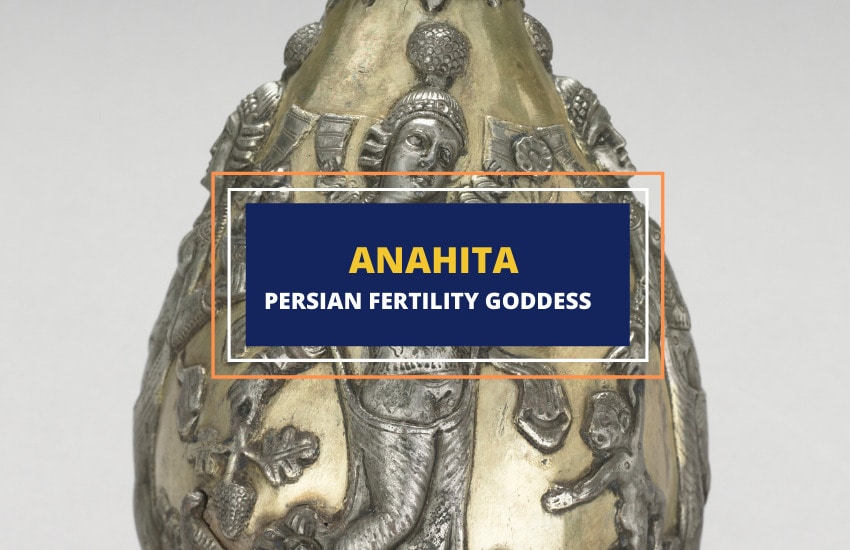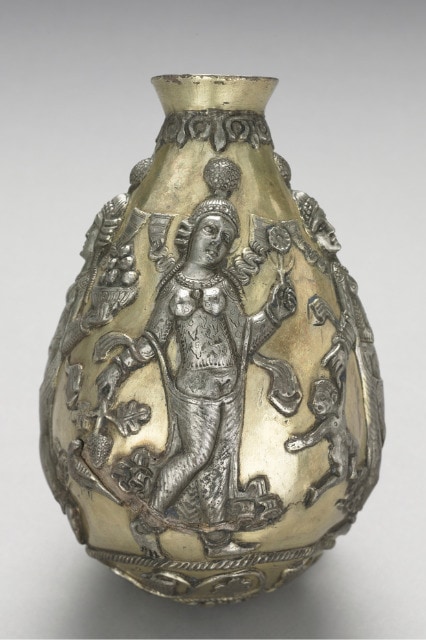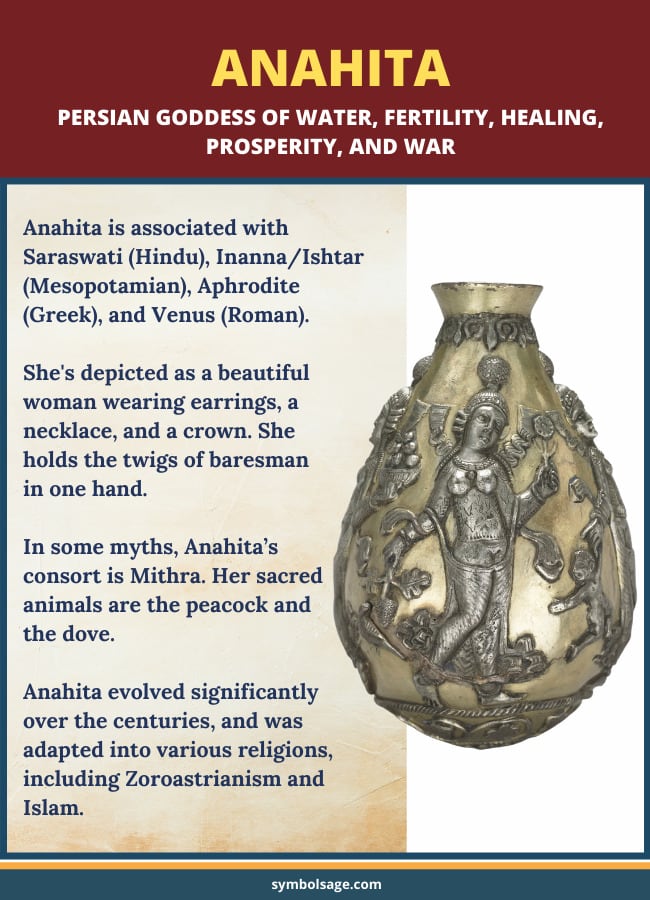
Table of Contents
There aren’t many mythologies out there that denote the same deity as representing both fertility and war. That sounds very much like it being a deity of both life and death. And yet, that’s exactly what the Persian Goddess Anahita is.
The reason for this apparent contrast lies in the complex history of Anahita. That multi-cultural history is also why Anahita is viewed as a goddess of royalty, water, wisdom, healing, as well as why she has many other names and is worshipped in multiple religions spread throughout the millennia.
Who Is Anahita?

Anahita belongs to one of the oldest religions we know of today – the ancient Persian/Indo-Iranian/Aryan religion. However, because of the numerous cultural and ethnic shifts that occurred in Central Asia and the Middle East over the past 5,000 years, Anahita has also been adopted into various other religions over the centuries. She even lives on as a part of the second-largest religion in the world today – Islam.
Anahita is described as a powerful, radiant, lofty, tall, beautiful, pure, and free female. Her depictions show her with a golden crown of stars on her head, a flowing robe, and a golden necklace around her neck. In one hand, she holds twigs of barsom (baresman in the Avestan language), a sacred bundle of twigs used in ritual.
Anahita in the Ancient Aryan Religion
The inception of Anahita is believed to lie in the ancient Persian polytheistic religion practiced by the Indo-Iranians (or Aryans) of the region. This religion was very similar to the polytheistic religion in India that later became Hinduism. Anahita played a main role in that connection, because at her core she was viewed as the goddess of the Heavenly River from which all water flowed.
Anahita’s full and “official” name in the Iranian language is Aredvi Sura Anahita (Arədvī Sūrā Anāhitā) which translates as Damp, Strong, Untainted. Anahita’s Indo-Iranian name was Sarasvatī or She who possesses waters. In Sanskrit, her name was Ārdrāvī śūrā anāhitā, meaning Of the waters, mighty, and immaculate. From that view of Anahita as a goddess of water and rivers comes her perception as a goddess of fertility, life, wisdom, and healing – all concepts that people across the world associated with water.
Anahita in Babylon
A second big piece of Anahita’s puzzling personality likely comes from ancient Mesopotamia. This connection is still a bit speculative but many historians believe that the cult of Anahita is connected to the cult of the Mesopotamian/Babylonian goddess Ishtar or Inanna.
She too was a goddess of fertility and was viewed as a young and beautiful maiden. Ishtar was also the Babylonian goddess of war and was associated with the planet Venus – two qualities that Anahita also “acquired” at some point before the 4th century BCE.
Similar theories exist about other ancient Mesopotamian and Persian deities so it’s very likely that the two cults did in fact mesh together at some point. Ishtar/Inanna is also likely the one who gave Anahita the additional title of Banu or Lady as the Persian goddess is indeed often called Lady Anahita. Likewise, the ancient Indo-Iranians called the planet Venus The Pure One or Anahiti.
Anahita in Zoroastrianism
Even though Zoroastrianism is a monotheistic religion, the Aryan goddess of fertility still found a place in it. When Zoroastrianism swept through the Middle East and Central Asia, the cult of Anahita was just absorbed into it instead of disappearing.
In Zoroastrianism, Anahita isn’t viewed so much as a personal goddess or as an aspect of Ahura Mazda, the Creator God of Zoroastrianism. Instead, Anahita is present as the avatar of the Heavenly River from which all water flows. Aredvi Sura Anahita is the cosmic source from which Ahura Mazda created all rivers, lakes, and seas in the world. The Anahita Heavenly River was said to sit on top of the world mountain Hara Berezaiti or High Hara.
Anahita in Islam
Of course, Zoroastrianism wasn’t the last religion to be worshipped across Central and Western Asia. When Islam became the dominant religion of the region in the 6th century AD the cult of Anahita had to go through yet another transformation.
This time, the goddess of fertility became associated with Bibi Sahrbanu or Shehr Banu – the wife and widow of the legendary Islamic hero Husayn ibn Ali. Husayn lived in the 7th century AD, from 626 to 680. He is said to have died in the Battle of Karbala, a conflict between the Islamic faction of Hussayn and the Umayyad Dynasty, which was more numerous at the time.
The Hussayns, led by Husayn ibn Ali suffered a devastating defeat and were martyred as heroes soon after. This battle is commemorated to this day during the Festival of Ashura because of how core it is to the division between Sunnism and Shi’ism in Islam.
So, what does the Indo-Iranian water goddess Anahita has to do with the widow of an Islamic hero? Nothing, really. However, the two cults of the water goddess and the hero’s widow likely converged because some of Anahita’s Zoroastrian shrines later became Muslim shrines devoted to Bibi Shehr Banu.
There is also a popular myth explaining how Husayn ibn Ali gave his wife a horse and told her to escape to her homeland of Persia the night before he himself rode to the Battle of Karbala. So, Shehr Banu jumped on the horse and rode to Persia but she was chased by soldiers of the Umayyad Dynasty.
She rode to the mountains near the Ray province in Iran – the same mountains believed to be the mythical Hara Berezaiti, where the Heavenly River resides – and she tried to call out to God for help. However, in her urgency, she misspoke and instead of yelling Yallahu! (Oh, God!) she said Yah Kuh! (Oh, mountain!).
Then, the mountain miraculously opened and she rode into it to safety with only her scarf falling behind her as proof. A shrine was then built upon the site. The connection to Anahita here lies both in the mountain itself as well as the fact that Bibi Shehr Banu’s shrine was once a shrine to Anahita. Additionally, the word Banu/Lady which Anahita took from Ishtar is also present in Bibi Shehr Banu’s name.
How strong that connection is is up for debate. However, what’s indisputable is that the majority of Bibi Shehr Banu’s shrines today were once shrines to Anahita.
FAQs About Anahita

Anahita was the Persian goddess of water, fertility, healing, prosperity, and war.
Soldiers would pray to Anahita before battles for their survival, which connected her to war.
Anahita is associated with Saraswati in Hinduism, Inanna or Ishtar in Mesopotamian mythology, Aphrodite in Greek mythology, and Venus in Roman mythology.
During Persian and Zoroastrian times, Anahita was depicted as a beautiful woman wearing earrings, a necklace, and a crown. She holds the twigs of baresman in one hand.
In some myths, Anahita’s consort is Mithra.
Anahita’s sacred animals are the peacock and the dove.
Wrapping Up
Of the ancient Persian deities, Anahita was one of the most loved by the people and was frequently invoked for protection and blessings. As a goddess, Anahita is complex and multi-layered, as she continued to evolve to suit the changing contexts of the region. She had many counterparts in other mythologies and was associated with several prominent goddesses.








